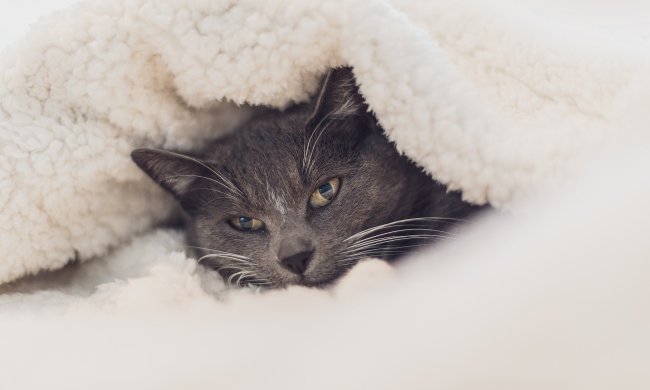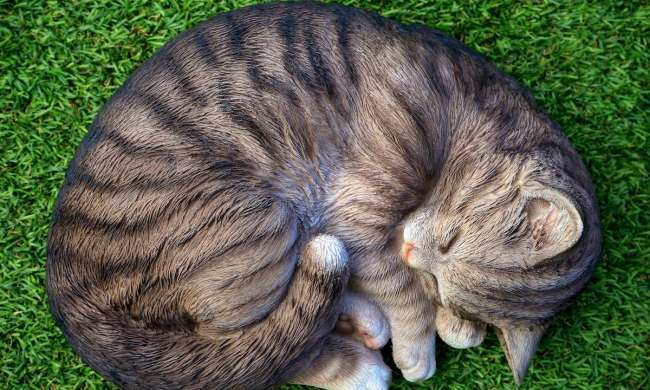Cats spend a large portion of their lives asleep, and many cats will appreciate having a comfy cat bed to curl up on. If it’s time for a new bed for your cat, you have plenty of options. So, what kind of beds do cats like? Most cats will enjoy a soft, comfortable bed that they can easily knead and reposition. Some cats prefer beds with higher walls for a more secure feel, and heated beds are a great option in lower temperatures. Certain beds tend to be big hits among many cats, and we’ve included some of the best cat beds available below to help narrow down your shopping choices and save you some time.
Pet Magasin Self Warming Cat Cave
The Pet Magasin Self Warming Cat Cave creates a cozy space where your kitty can snooze. This bed functions as four insulated beds, so you can arrange it to act like a cavern, an upright cup, a flat lounge, or a pod. Flip it and rearrange it — no matter what position it’s in, it’s warm and soft. You can also determine which shape your cat prefers most. This bed features a ultrasoft faux-fur interior as well as plenty of fleece and foam padding. The microfiber exterior is made with anti-microbial fabric for your cat’s health, and it’s supereasy to clean and store when needed.
Meowfia Premium Felt Cat Cave Bed
With the Meowfia Premium Felt Cat Cave Bed, your cat will enjoy premium comfort as he’s wrapped in New Zealand merino wool. This cat cave bed is handcrafted by Nepalese artisans, making it warm in the winter and cool in the summer for the purr-fect sleeping temperature. Wet felting creates the dense fabric, and the bed is made from a single piece of fabric so you don’t have to worry about seams wearing out. The felt is anti-bacterial for a fresh and healthy bed. The 8-inch opening keeps the interior secure and cozy, and the bed is suitable for cats up to 20 pounds. Choose from four different colors.
K&H Pet Products Thermo-Kitty Fashion Splash Heated Cat Bed
The K&H Pet Products Thermo-Kitty Fashion Splash Heated Cat Bed delivers the perfect temperature for catnaps and deep snoozes. It plugs in and then warms to your cat’s body temperature for an extra-cozy sleeping spot. It’s ideal for winter warming, or it can support cats with arthritis and other ailments all year long. The energy-efficient heater will save you money on your utility bills, while the orthopedic foam base makes the bed deeply comfy. An overstuffed poly-filled bolster creates a border to the bed for a secure feel and doubles as a pillow. The bed measures 22 by 16 inches, so it will fit perfectly on a chair, your couch, or your bed.
Love’s Cabin 20 Inch Cat Bed
The Love’s Cabin 20 Inch Cat Bed creates a soft and cozy nest that makes your cat feel extra secure. The raised rim supports your cat’s head and neck, but you might find him curled up into a perfect ball in the plush center. The premium shag fur is soft and warm, and the bed is filled with a high-loft down alternative. Cleaning the bed is easy — you can throw the whole thing into the washing machine with the cover still on. This bed measures 19.6 by 19.6 by 4.7 inches and will fit easily on top of most chairs or in your cat’s favorite sleeping space. The 20-inch size is just right for most cats, but cats over 15 pounds may be more comfortable in the 24-inch version. Choose from seven colors.
When choosing the best cat bed for your kitty, think about the types of spaces he typically seeks out for a nap and look for a bed that replicates those qualities. Some cats like dark, enclosed spaces and may burrow under blankets to catch some z’s. These cats may prefer a cat bed with high sides or one that’s fully enclosed. Other cats seek out warm spaces in front of heaters and might be attracted to a heated cat bed. When your new bed arrives, place it in a spot where your cat likes to sleep and be patient. Adding some catnip to the bed can help build your cat’s interest, but your cat will have to accept and start using the cat bed in his own time.


